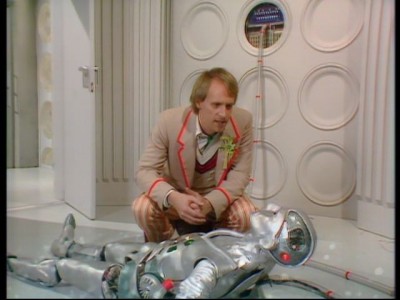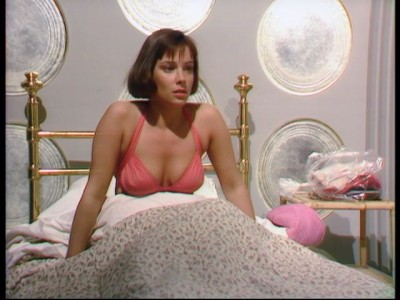The Caves of Androzani

Story 135
Written by Robert Holmes, directed by Graham Harper
Transmitted: 8–16 March 1984
“You have the mouth of a prattling jackanapes, but your eyes tell a different story.”
Doctor Who had been running for 21 years in 1984. The program had been many things; comedic, historical, dramatic and strange… but rarely was it as dramatic and action-oriented as it was in The Caves of Androzani. The story is something of a worst case scenario. Each week, viewers had traditionally seen the Doctor and his companion(s) arrive in a situation, get captured, escape, and foil the villain. In this story the setting is far more violent and the villains outside the ability of the Doctor’s powers to stop them. This is not a tale about alien invasion or mad scientists. This is a story about corrupt business and government involved in a never-ending drug war. Seldom had Doctor Who attempted to tell such an important story, translating current events through its unique lens of science fiction. But this story used a script by one of the all time great authors of Doctor Who, Robert Holmes (Spearhead from Space, Carnival of Monsters, The Time Warrior, The Ark in Space, Pyramids of Mars, The Brain of Morbius Talons of Weng Chiang, etc) in perhaps his best form. It was also directed by Graeme Harper, a young somewhat newcomer to the role who would go on to direct some of the most striking Who stories ever (even into the new program when he returned for Rise of the Cybermen/The Age of Steel, Doomsday, 42 and more.
Peter Davison had signed on for three years as the Doctor when he was asked to take on the part by John Nathan-Turner. During the program’s 20th series, Davison’s second, he became increasingly frustrated and decided to stick to this plan. He later regretted this decision as his final year was a vast improvement (and it shows in his performance that he was far happier with the material as well), but we will never know what a fourth year of Davison as the Doctor would be like. Yet, if you are going to go out… there are few swan songs better than Caves of Androzani.
Looking for some sand for an off-screen repair job, the Doctor lands on desolate Androzani Minor. When Peri points out that they are surrounded by sand, the Doctor points out that he requires specific sand for his glass blowing, a technique that he learned in a monastery long ago. All of this dialog is lost on screen, but contained in the script which develops the interplay of the Doctor and Peri, something that will become more important as the plot unfolds. The Doctor is famous for walking blindly into dangerous situations, but here Peri vocally asks herself it is wise to just wander into some dank caves on an alien world.
Soon, Peri has become infected with a fungus unknown to the Doctor and they have become embroiled in a private war between troops from Androzani Major and some mercenary gun-runners supplying arms to the rebel Sharaz Jek. Mis-identified s criminals, the Doctor and Peri are executed by firing squad.
The powerful Trau Morgus watches the events unfold from Androzani Major, where he brokers deals with the government to prolong the war indefinitely. Unfortunately, the President of the local government has decided to bow to the public’s need for spectrox, a unique miracle drug that can more than double one’s life form, a material found only on Androzani Minor which is under control of Sharaz Jak and his army of androids.
While it appears that they are dead, Peri and the Doctor were actually replaced by android replicas at the last minute and abducted by Jak. They find that their savior is somewhat mad and driven by a vengeful blood food with Trau Morgus that goes back many years when Morgus left Jak for dead in a mud flow. It becomes clear early on that the Doctor is stuck in a dire complicated situation that he must extricate himself from before he and/or Peri are killed. Then he discover that the fungal infection is terminal. The odds have seldom been so against the Doctor and rather than vanquish evil, he must instead dig deep if he hopes to survive this time.
Using his wits, the Doctor escapes captivity only to become captured by Stotz and headed back to Androzani Major to meet his employer, Trau Morgus. Yes, Morgus is playing both sides of the war on drugs and profiting quite well. Somewhat madly, the Doctor breaks his restraints, gains control of the ship and crashes it back on Androzani Minor. Dodging bullets fired by the mercenaries and explosion of scalding mud shooting from the center of the planet, he desperately attempts to find a cure to spetrox toxemia… this in turn leads to a quest into the bowels on the planet to draw milk from the giant vampire bats.
Not an easy day for the Doctor. I am puzzled if there is a single story in which he must undertake a more demanding quest that challenges him to the limit of his abilities.
The performances of the guest cast are phenomenal from John Normington as the conniving Morgus (who strangely delivers monologues directly to the audience) to Maurice Roëves as the gun-runner Stotz. However the real star here is ex-ballet dancer turned actor Christopher Gable as Sharaz Jek. There is a fine line between going over the top and delivering a solid performance as a villain in Doctor Who and Gable hit the mark dead center. Largely covered head-to-toe in leather, his Phantom of the Opera-like Jek creepily fondles Peri every chance he gets and exchanges barbs with the Doctor that indicate his intelligence and scarred psyche. He is one of the absolute best and most tragic of Who villains.

The Doctor confronts the villainous Sharaz Jek

Peri is terrorized by Sharaz Jek
While Holmes’ script and Harper’s direction are stunning and it cannot be argued that this is Davison’s strongest performance as the Doctor, it is difficult to talk about this story without bring up the ending. Previous regeneration stories (Tenth Planet, The War Games, Planet of the Spiders and Logopolis) approached the notion of one era ending and another beginning in their own way. Harper, however, had his own vision. Late at night, the director later recalled, he had been listening to the Beatles’s A Day in the Life and was inspired by the ending of the song in which a symphonic cacophony builds to a veritable explosion. He got the idea that regeneration was similar, as the Doctor’s previous life flashed before him and he was blinded by a steadily building eruption of cellular rebirth.
The moment remains the finest depiction of regeneration, even by the standards of the current program which is no doubt inspired by Harper’s vision. In Logopolis, we had seen the Fourth Doctor haunted by images of his old travelling companions and vicious foes urging him to accept death, giving the impression that it was a personal struggle to push this change into motion. In Caves of Androzani, this is amped up as an argument takes place between his companions who encourage the Doctor to live on only to be countered by an overwhelming image of the Master who all but commands the Doctor to die. It’s a very emotional moment, made all the more poignant by the appearance of young Adric, whom the Doctor had failed to save.

The Fifth Doctor meets his final end

Peter Davison’s finest hour is upstaged by… Nicola Bryant’s cleavage

“Change, my dear… and not a moment too soon.”- the new Doctor arrives
The resultant arrival of Colin Baker, looking more lively and vibrant than ever, is almost disturbing. There is no touch of hopeful rejuvenation or of beating back death. This Doctor is a stranger who is far more alien than any other incarnation to date (but that’s another story…).
As classic stories go, The Caves of Androzani has a massive reputation for being one of best alongside Genesis of The Daleks, Carnival of Monsters and Talons of Weng Chiang. The non-stop action, unusual direction and superb guest cast make this story stand out on its own. It is thrilling to watch the development of the Fifth Doctor, who had traditionally remained on the sidelines, spring forth to rescue his companion in the end. Fans of the modern program are less likely to be surprised by this, but at the time it was startling to see such a strong focus on saving Peri, a companion that he hardly knew. This is of course more of a reaction to the Doctor’s guilt over Adric’s death and how he has steadily witnessed the universe around him darken into a violent place (as seen in Warriors of the Deep, Resurrection of the Daleks and Frontios). I bring this up because Classic Doctor Who was so much a serialized program that lacked the resources to develop a character, yet if one looks closely that is what happened with the Fifth incarnation, building toward this moment in which he realizes that to save just one life, he is willing to sacrifice his own.
For Doctor Who fans at the time who had quickly grown to love Peter Davison as the youthful and often confused yet brave Doctor, this was a very powerful moment that has yet to be topped in the program’s history. There was an opportunity in Tennant’s reign to similarly address this but it all got very self-serving in the end, didn’t it? ‘I don’t want to go’ indeed. Yuck.
Highly recommended and available n Netflix.
Also recommended :







 Story 121
Story 121





















 Story 134
Story 134








 Story 123 Written by Johnny Byrne, directed by Ron Jones
Story 123 Written by Johnny Byrne, directed by Ron Jones













 Story 130
Story 130










